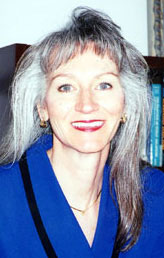
[an error occurred while processing this directive]

Today@Sam | Headlines | Calendar | Experts | Notices | Archives | Search
Public School Study Shows
Technology Not Being Fully Used
 Public school teachers have more technology than they know how to use, according to a recent study conducted by a Sam Houston State University researcher.
Public school teachers have more technology than they know how to use, according to a recent study conducted by a Sam Houston State University researcher."It is well known that technology can make learning more interesting and meaningful to students," said Rowan Ljungdahl, left, a faculty member in the Center for Research and Doctoral Studies in Educational Leadership at SHSU.
"However, many teachers are uncomfortable using technology in the classroom because they are unfamiliar with how to successfully integrate the technology into instruction."
Ljungdahl surveyed 856 elementary and secondary teachers from 39 campuses in 25 different school districts in the SHSU service area, including the Houston urban and suburban areas, as well as outlying rural districts. She found that only 40 percent of the teachers used some type of technology every day.
This is despite her finding that almost three-fourths of the teachers (73.5 percent) had access to Microsoft Word, slightly less (69.6 percent) had access to Power Point, and almost all had overhead projectors (96.2 percent), television sets (92.8 percent) and video cassette recorders (89.9 percent).
The most effective use of technology, said Ljungdahl, is when two or more different types of technology are used in the same lesson. More than two out of three (67 percent) of the public school teachers said they used this type of presentation, but only once a week.
Use of technology in classrooms is important not only because it increases teaching effectiveness, said Ljundahl, but it also helps overcome what she calls the "digital divide." This is the gap between those who have access to personal computers and those who don't.
About four out of five students with a household income of $75,000 or more per year have a computer at home, said Ljungdahl, but only one in five students with a household income of $30,000 or less have a computer at home.
The Telecommunications Infrastructure Fund Board (TIF) is a grant program to assist schools in implementing some of the newer technologies, such as Internet access. Telecommunications companies pay into the fund and state officials distribute the money to schools.
Almost three out of four (74.3 percent) of the public schools have taken advantage of the funding provided by the grants, with 73.3 percent receiving funding toward Internet access. This would appear to give Internet access to many students on the wrong side of the "digital divide."
Less encouraging, however, were findings from rural and remote school districts. Only 26.7 percent of those districts have applied for and received TIF Tier II funds, which are reserved for such districts, according to Ljungdahl's survey.
"Based on this study, it seems that schools should provide teachers with training in the integration of technology into classroom instruction," said Ljundahl. "This training should be long term and continuous, and it should provide basic skills information as well as curriculum integration."
As a result of information gathered in this study, curriculum for new elementary teachers in Sam Houston State University's College of Education and Applied Science has been modified to include such training. The training was already in place for new secondary teachers, as well as for those seeking master's and doctoral degrees. Additional courses, degrees, or certification is one solution, with training within the districts being another.
"With the technology already in place," said Ljundahl, "the proper training should allow experienced teachers and student teachers to successfully integrate technology and increase student achievement."
- END -
SHSU Media Contact: Frank Krystyniak
April 18, 2001
Please send comments, corrections, news tips to Today@Sam.edu
This page maintained by SHSU's Office of Public Relations
Director: Frank Krystyniak
Communications Coordinator: Julia May
Located in the SHSU University Advancement Building
Telephone: 936.294.1836; Fax: 936.294.1834
